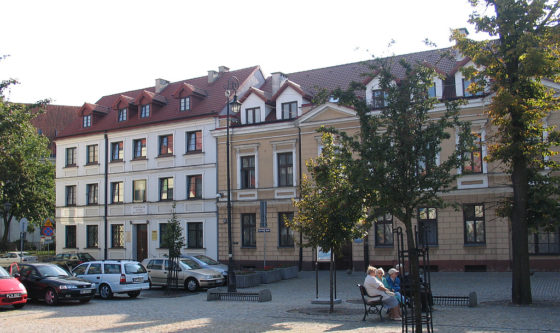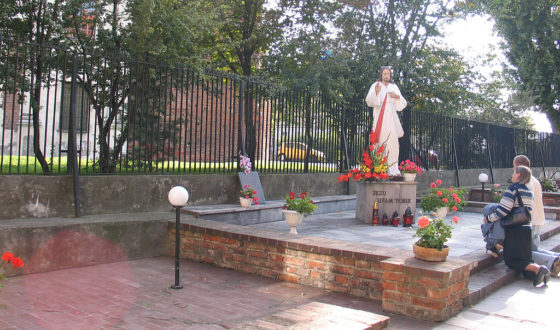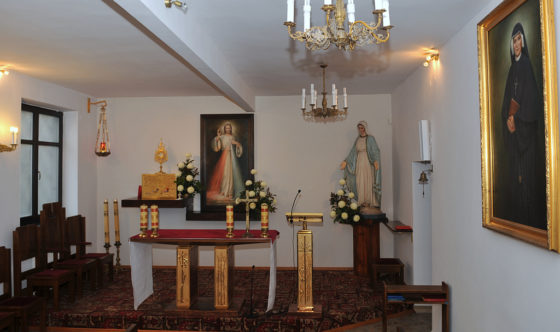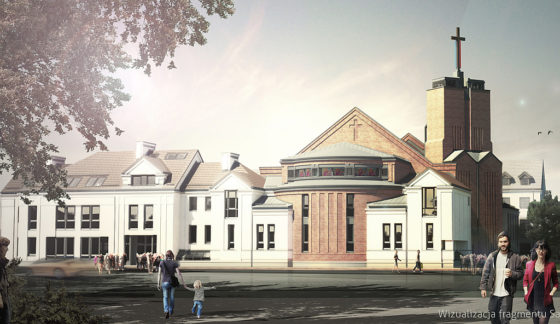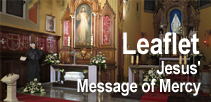The Shrine of The Divine Mercy in Płock, the place where the great prophetic mission of St. Sister Faustina Kowalska began, is loca- ted at 14/18 Old Market Square, in the convent building of the Congregation of the Sisters of Our Lady of Mercy. On account of its historic nature, as the place where Jesus was revealed to Sister Faustina, instructing her to paint His picture with the inscription: Jesus, I trust in You and demanding the establishment of the Feast of The Divine Mercy in the Church; and also because of the many pilgrims attracted there; the Congregation chapel was eventually raised to the rank of the Shrine and a rectorate was established there. This was carried out by the Ordinary of the Płock Diocese, Bishop Stanisław Wielgus, on 30 April 2000, the day of Sister Faustina’s canonization. Every 22nd day of the month (on the day of the revelation of Jesus Christ to St. Sister Faustina) solemn services are held in honour of The Divine Mercy. Every day Masses are celebrated (in the morning and afternoon). At 3pm there is communal prayer at the Hour of Mercy followed by the Chaplet of The Divine Mercy. All day there is Adoration of the Blessed Sacrament and the ministry of priests in the confessional. All this is taking place now in a temporary chapel, because construction works connected with the building of a new church are being carried out in the place of the revelations.
The convent of the Congregation is situated on the Vistula River on Wzgórze Tumskie (Tumskie Hill), in the old part of the city of Płock. This city has a very rich history dating back to the 10th century. The beginnings of the ministry of mercy in Płock convent are associated with the person of Bl. Archbishop Antoni Julian Nowowiejski, who already as priest founded the “Guardian Angel” institution (Zakład Anioła Stróża) for poor girls and the non-habited Congregation of Divine Love (Zgromadzenie Bożej Miłości) for the educational work with the poor girls. On 13 April 1899 this Congregation (on its founder’s advice and by his efforts) merged with the Congregation of the Sisters of Our Lady of Mercy, an experienced institution in such apostolic work, these sisters being brought to Płock from Warsaw. The sisters started their work according to their charisma, and consequently the “Guardian Angel” institution developed successfully. Initially about 50 penitents stayed in it, and when a branch house in Biała near Płock was opened – over 100 wards were housed there. They, depending on their talents, worked under the direction of the sisters in the laundry, a sewing room, an embroidery workshop or on the farm in Biała. Prayer and work determined the rhythm of life of the sisters and their wards. Work was not only the main source of income for the convent and the “Guardian Angel” institution, but also an important educational measure, preparing the girls for a worthy life in society. The institution enjoyed the recognition of the Church, city authorities and residents of the City of Płock. Archbishop Julian Nowowiejski was the great patron and friend of the house, and the author of the book Dzieje Instytutu Matki Bożej Miłosierdzia (History of the Institute of Our Lady of Mercy). In 1918 the convent and the “Guardian Angel” institution at the Old Market Square were visited by Fr. Achilles Ratti, later Pope Pius XI.
The Superior General, Mother Michael Moraczewska, sent Sister Faustina Kowalska to this convent in the late spring of 1930, allocating her for work in the bakery shop, where many inhabitants of Płock would come daily to buy bread. The first historical event for the devotion to The Divine Mercy took place in the annex of the convent at the Old Market Square, namely the first revelation of the Merciful Jesus, which began the public mission of St. Sister Faustina. On 22 February 1931 Jesus appeared to her as represented in the picture “Jesus, I trust in You”. She described this event in her Diary: “In the evening, when I was in my cell, I saw the Lord Jesus clothed in a white garment. One hand [was] raised in the gesture of blessing, the other was touching the garment at the breast. From beneath the garment, slightly drawn aside at the breast, there were emanating two large rays, one red, the other pale. In silence I kept my gaze fixed on the Lord; my soul was struck with awe, but also with great joy. After a while, Jesus said to me, “Paint an image according to the pattern you see, with the signature: Jesus, I trust in You. I desire that this image be venerated, first in your chapel, and [then] throughout the world. I promise that the soul that will venerate this image will not perish. I also promise victory over [its] enemies already here on earth, especially at the hour of death. I Myself will defend it as My own glory.” (Diary 47-48). In the Płock convent, Sister Faustina also heard the command of Jesus to establish the Feast of The Divine Mercy on the first Sunday after Easter. Therefore the “luminous path” began here, on which Jesus gradually passed to her the prophetic mission to remind the world of the truth of His merciful love for every human being.
In 1939 the first image of Merciful Jesus painted according to the vision of Sister Faustina was placed in the chapel. The years of World War II favoured the spread of the devotion to The Divine Mercy in the forms given by Sister Faustina. The sisters of the convent in Płock not only prayed before the image of Merciful Jesus, but also popularized the devotion, among other things by handing out medallions and holy pictures with the Chaplet and by sending them in food packages to camps and prisons.
In the 1950s the communist authorities removed the sisters from the convent in Płock, and nationalized both the convent and the “Guardian Angel” institution. After 40 years (so in the 1990s) the Congregation regained their property, though in a dilapidated state, and with the help of benevolent donors started to restore the historic buildings. With the settling in of the sisters and the opening of the chapel, the devotion to The Divine Mercy once more began to revive and develop in this place. First a copy of the famous Miraculous Image belonging to the Shrine in Kraków-Łagiewniki was placed in the chapel, and then the image of Merciful Jesus (painted by Elżbieta Plewa-Hoffmann), which in the years from 1992 to 2000 travelled through all parishes of the Diocese of Płock. The convent at the Old Market Square became a place of practising, proclaiming and interceding for mercy for the world, and the place of many pilgrimages from Poland and elsewhere. On their return to Płock, the sisters dealt not only with rebuilding and repairing the devastated buildings, but more importantly they undertook with great zeal and energy the mission of preaching, interceding and practising mercy, in addition to carrying out the charismatic mission of the Congregation, first in a preschool centre, in the centre for girls, and then in an extramural care centre, and on top of all that looking after the pilgrims.
On 30 April 2000 the convent chapel was raised to the rank of the Diocesan Shrine of The Divine Mercy. Today in the place of the revelations a new church and appropriate facilities are being built for the pilgrims, for the formation of the Apostles of The Divine Mercy, for a retreat centre and for works of mercy towards those in need of moral support. In spite of the construction work going on around them, the sisters’ apostolic mission continues. They work at the Studnia Diocesan Youth Chaplaincy, and take care of “the window of life” or “the baby hatch” (a place where mothers can leave infants for adoption if they cannot or do not wish to raise them), which was established at the convent. However, their main task is to serve the pilgrims who come to this place. The Shrine is a place of prayerful retreat for many individuals and groups. It all goes to make the Shrine in Płock a real meeting place with God rich in mercy.
Sr. M. Elżbieta Siepak ISMM
Translated by Orest Pawlak











